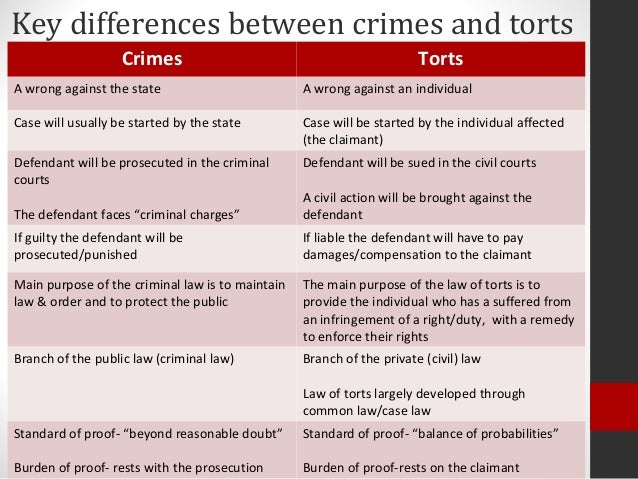This article consists of 06 pages and 2090 words. In order to have full access to this article, email us at thedocumentco@hotmail.co.uk
Ref No: 964

What is the difference between a “tortious act” and a “criminal act”?
Tortious act vs criminal act:The difference between the two can be described in terms of the legal definition and the implications of the law in accordance with the legal proceedings. A criminal act is a crime against the state while a tortious act is an offence against the basic rights of a person.
.Crime against the state refers to the failure to abide by the statutory law which is defined for every resident of a state or country. A tortious act on the other hand might not be specifically defined in the statutory law but it indirectly incurs an injury to a person or their property (Schafer, H. B. 2000, p. 569).
The criminal proceedings are the responsibility of a state while the law of tort needs the victim to pursue the legal proceedings. The criminal offence results in incarceration, fine or both while the law of tort is devised only to pay for the damages which are caused by the offender (defendant) to the victim (plaintiff).
- What did the case of Donoghue v Stevenson (1932) contribute to the development of the law of negligence?
The Donoghue v. Stevenson (1932) was the first case in which the law of tort was used to charge the respondent/defendant with damages despite the absence of a contractual agreement between the two (E-Law Source).Tortious act vs criminal act
Previously, the civil law dictated that to prove any negligence, the plaintiff had to produce a contractual agreement which binds the respondent to certain responsibilities but in this case, the ginger beer was presented to Ms. Donoghue as a gift from a friend which means there was an absence of the agreement under which Mr. Stevenson’s product had to maintain certain standards.
Hence, the decision of the court in this case was distinguished due to the fact that law of negligence was implemented without any precedents, stating that Mr. Stevenson had a responsibility that his product may not incur any harm to the people who use it and due to his neglect, he was charged with a fine.
- Define the three stage test established in Caparo v Dickman (1990).
The three stage test established in the Caparo Industries Plc vs Dickman (1990) suggest three tests that the claimant has to pass for the viable application of the duty of care. The claimant has a duty to prove that all three conditions suggested by the test hold true. The three tests include:
- The harm was reasonably foreseeable. This means that the defendant, not aware of the harmful situation may be, but knows that the situation can be harmful and if he/she knew about the situation, they would know its potential harm.
- The relationship of proximity which essentially means that one party must be concerned with the harm done to the other party.
The imposition of duty of care must be fair, just and reasonable

Recent Comments